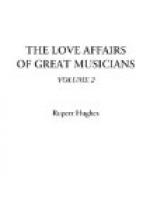“I would choose Hiller for my friend, Chopin for my husband, Liszt for my lover.”
There seems to have been a snow-storm of love affairs at this period. It is impossible even to name the flakes. Gossip of course gathered into the catalogue every woman whom Liszt saw more than once; but we need not pay this tribute to malice by mentioning the names of all of Liszt’s hostesses. Among those who may be more definitely suspected of being made victims by, or victimising, him is the Comtesse Adele Laprunarede, afterward Duchess de Fleury. She, of course, was, as De Beaufort says, “sparkling, witty, young, beautiful.” Her home was lonely and rural; her husband was very old; Liszt, to repeat, was a musician and Hungarian. The old comte was blind enough to invite him to spend the winter months at his chateau. For a whole winter Liszt was kept there in her castle a prisoner, with fetters of silk. The old comte seems never to have suspected. When Liszt eventually, like Tannhaeuser, mutineered against the charms of the Venusberg and returned to Paris, he wrote many letters to the comtesse, in which, as he himself said, he gained his “first practice in the lofty French style.”
But this intrigue was followed by his appearance in the procession of George Sand’s lovers. Ramann, in his biography, writes of the curious state of society of the Paris of this Revolutionary period: “Women were beginning to demand freedom and to experiment with the writing of perfervid romances, which questioned the very foundation principles of marriage and made a religion of Affinity.”
George Sand was a chief crusader against the curse of monogamy. She practiced this anarchy in the guise of religion, as the old crusaders out-heathened the barbarians, and raided civilisation in the name of the Cross. George Sand’s gospel, summed up briefly by Ramann, is as follows:
“‘Love,’ says the authoress, ’is Christian compassion concentrated on a single being. It belongs to the sinner, and not to the just; only for the former it moves restlessly, passionately, and vehemently. When thou, O noble and upright man,’ she continues, with deceitfully fantastic warmth, ’when thou feelest a violent passion for a miserable fallen creature, be reassured that is genuine love; blush not therefore! so has Christ loved who crucified him.’ According to this view, the love that sins from love must be virtue. One can scarcely be alarmed then when she says: ’The greater the crime, so much the more genuine the love which it accomplishes;’ or, when Leone Leoni, steeped in passion and crime, but talented and adorned with manly beauty, exclaims to his beloved, ’As long as you hope for my amendment you have never loved my personal self.’ It also appears to correspond with this casuistry of erotic fancy, when the heroes of her tragedies, of sky-storming earnestness, but adorned with all unnatural qualities, give themselves up to the latter as to an intoxicating spell, and in the delirium of self-delusion hold sin for virtue, and the unnatural for higher truth and beauty. With this creed, experimental love was a logical sequence, and great constancy was already to be unprogressive stubbornness. ‘All love exhausts itself,’ said Sand in ‘Lelia’; ’disgust and sadness follow; the union of the woman with the man should therefore be transitory.’”




